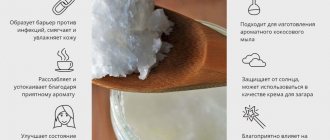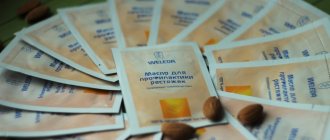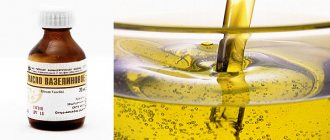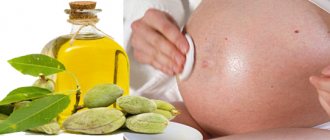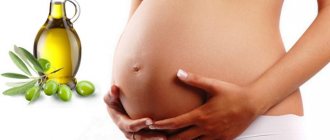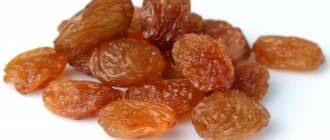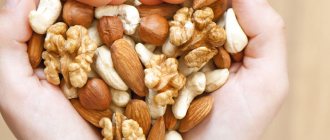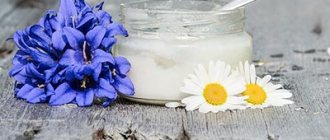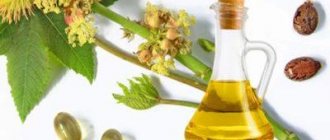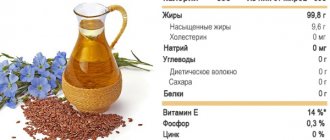Grandmother's funds
Many parents are afraid to treat their newborn's skin with baby cosmetics after bathing , fearing the harmful effects of the chemicals they contain. Then it’s worth remembering what our mothers and grandmothers also used.
the use of boiled vegetable oil to prevent diaper rash to be outdated, but many resort to this proven method of caring for children’s skin, believing that vegetable oil without fragrances or any additives will most likely not cause allergies in the child.
How to properly prepare vegetable oil for use after bathing
Processing folds
To keep your baby's skin healthy, you need to bathe him daily, and in hot weather you can do this twice a day. When bathing a newborn, you should not overuse soap (it is optimal to use it once a week). It is better to replace baby soap with milder detergents.
After taking a bath, dry your baby's body with a soft towel or diaper, while avoiding friction, which can cause damage to the skin. Then examine all folds for irritation, diaper rash, allergic reactions, powder and oil residues. Examine the folds on the neck, as the most vulnerable place, pay attention to the place behind the ears, palms, fingers, elbows, armpits, legs, inguinal, buttock folds and the genitals of the newborn - redness often occurs there.
This is best done not only after an evening swim, but also in the morning.
After examination, treatment of the newborn’s folds is necessary, which can be done by various means:
- The folds are sprinkled with baby powder or, as our ancestors did, with starch.
- Lubricate with special oil, sold in children's stores and pharmacies. Boiled vegetable oil or Vaseline oil will also work;
- Many people use baby cream for preventive purposes.
What baby folds look like (Photo)
Preference should be given to what is most relevant to a specific problem. For example, if the baby's skin is dry, you will need oil to moisturize it, and if the folds become wet, it is better to sprinkle them and dry them. You should not use both oil and powder at the same time; this can provoke an inflammatory process, since when they are mixed, lumps are formed, which contribute to diaper rash and irritation.
- In order to treat the folds of a newborn with oil, you need to moisten a cotton pad and lubricate them sequentially from top to bottom. Pay special attention to your baby's neck, armpits and groin.
- For deep skin folds, it is best to use baby powder; the oil in this case can contribute to diaper rash.
- The cream is used when the child has pronounced dry skin, but in order to avoid diaper rash, it is not recommended to apply it directly to the folds. Cream and oil should not be applied directly to the baby’s skin, since a large amount of it can create a film on the surface of the body and negatively affect its condition. Mom must first apply a little cream to her hands, distribute between her palms and then treat the folds.
Air baths are necessary for the health of a newborn's skin. Do not rush to dress your baby immediately after bathing and treating the skin; give him time to lie down without clothes and a diaper.
Useful video by Dr. Komarovsky
Dr. Komarovsky will talk about the nuances that he first of all recommends paying attention to when treating the skin of a newborn .
Proper care of a child's skin is his health and well-being. Everyone's skin is individual, and it is difficult to give one-size-fits-all advice on what creams and powders to use after bathing. For some lucky ones, almost any product is suitable, while others have to spend money on expensive hypoallergenic ones, while others successfully use traditional homemade ones. If something doesn’t suit you, don’t be upset: the choice today is quite large, you can easily find a replacement.
Essential oils from a children's medicine cabinet. Aromatherapy first aid kit
So, if you set out to assemble a children's first aid kit for aromatherapy, it is advisable to include the following items in it:
For newborns from two weeks to two months:
Your medicine cabinet must have a base oil or carrier oil: almond oil, grape seed oil.
- lavender oil
- chamomile oil
- rose oil
From two months to a year you can add:
- orange oil (optional)
- cinnamon oil (optional)
- lemon oil
- sandalwood oil
from 1 year you can add:
- mint oil
from 2.5 years you can add
- eucalyptus oil
from 6 years old you can add:
- geranium oil
- rosemary oil
- tea tree oil.
- thyme oil
From 12 years old you can add:
- clove oil
Orange oil has a calming and at the same time tonic effect, relieves depression and insomnia, improves mood, normalizes blood pressure, and is an antiseptic.
Geranium oil has an anti-stress effect, improves skin tone, has a beneficial effect on infectious diseases of the oral and nasal cavity, and removes toxins.
Clove oil improves memory, promotes rapid recovery after psychological and physical stress, and has antibacterial and antiviral properties.
Cinnamon oil improves mood and helps in the treatment of ARVI.
Lavender oil has an anti-stress, sedative effect, helps fight insomnia and depression, stimulates the regenerative function of skin cells, and has an antiseptic effect.
Lemon oil is an excellent remedy for influenza, ARVI, and has a pronounced antibacterial effect. Lemon essential oil helps relieve stress and focus.
Japanese mint oil (can be used from 1 year of age) improves mood, is useful for throat infections, helps against motion sickness, and softens cough.
Chamomile oil has a sedative effect, has a beneficial effect on the skin, helps against diaper rash, prickly heat, and stimulates appetite
Rosemary oil (from 6 years of age) helps cope with stress, invigorates and improves mood, fights colds and its manifestations.
Rose oil is an excellent remedy for combating childhood insomnia, anxiety, and stress. Suitable for caring for baby's delicate skin. Gives a good preventive effect against ARVI.
Sandalwood oil has a relaxing effect, promotes sleep and relief from insomnia, and stimulates the immune system.
Tea tree oil (from 6 years of age) has an antiseptic and antibacterial effect and is used to treat the skin in the area of cuts, scratches, and wounds.
Thyme oil (from 6 years of age) helps cope with chronic fatigue, helps with a runny nose, cough, fights inflammatory processes in the bronchi and trachea, and is a natural immunostimulant.
Eucalyptus oil (from 2.5 years) has an anti-cold effect, softens coughs, reduces swelling and relieves muscle pain, helps with skin infections, and invigorates.
When using aromatherapy oils:
- Avoid contact of oil and its vapors with the child’s mucous membranes and eyes. This can cause discomfort, make you cry, and instill a negative attitude towards healthy aromas. Never apply pure oil to the skin or give it internally to a child.
- For baths, inhalations, compresses, do not use pure oil, but mix it with the base. To take a bath, add essential oil to a glass of milk, mix with a tablespoon of carrier oil or a tablespoon of honey to distribute evenly in the water. By following this rule, you will protect your child and yourself from overdose.
- Test before using any oil. If you are going to scent a room, do inhalations or bathe your child with oil, apply a drop to a piece of natural fabric placed in a container from a Kinder Surprise toy and let your child smell it several times a day. If undesirable effects (headache, dizziness, nausea, discomfort in the mouth and nasal cavity, redness of the eyes and skin) are not observed within 24 hours, the oil can be used in a home medicine cabinet. If you are going to apply it to the skin (in combination with a base, of course), apply the diluted oil to the bend of your elbow and observe for 24 hours.
- When using essential oils in aromatherapy, stick to the dosage. The oil is dosed in drops, which is why the bottle should have a dispenser. The golden rule for using essential oils is: it’s better to use too little than too much. This is explained by the property of essential oils to cause unpleasant side effects (headache, anxiety, excessive emotional arousal) when used in quantities greater than necessary. For children under one year old, you can add 1 drop of essential oil; after a year, the dosage can be increased by one drop. For children from five to twelve years old, the concentration of oils should be half the adult dose. From the age of twelve you can use adult doses.
- Remember the principle of gradualness; aroma sessions for children should start from 1-3 minutes (for children under one year old - 30 seconds) and gradually increase to half an hour. When inhaling, you should start with a few seconds, gradually increasing to 3-5 minutes.
- To aromatize the room in which children are located, in order to avoid burns, fires and other misunderstandings, it is better to use not an aroma lamp with a candle, but figurines made of terracotta or untreated wood. You can also hang aroma medallions.
Causes of diaper rash
Most often, diaper rash occurs in newborns and children in the first year of life for the following reasons:
- poor quality diaper;
- staying in a diaper for a long time;
- lack of daily water procedures;
- intolerance to the powder used to wash children's clothes;
- tendency to allergic reactions;
- improper nutrition of the mother while breastfeeding, which can lead to frequent bowel movements;
- a change in the pH of feces towards a more acidic side, which leads to even greater irritation of the skin.
Favorite places for diaper rash are the natural folds of the skin (groin, buttocks, armpits), less often - the folds behind the ears, the lower abdomen. Mostly diaper rash occurs in the groin and butt.
Why use it?
Children's skin only superficially resembles the skin of adults. Its physiological and anatomical differences from the skin of mom and dad are numerous. First of all, the child’s skin is thinner, the layer of subcutaneous fatty tissue is almost half as large, which makes the child vulnerable to the environment, which can be quite aggressive.
From the first minutes of independent life outside the mother's womb, the skin takes on a large burden associated with adaptation. Now the baby will have to live not in the sterile conditions of amniotic fluid, but in an atmosphere in which bacteria and fungi are normal. This is why infant skin can react so violently to any unfavorable external circumstances.
The task of parents is to ease this burden as much as possible and make conditions more favorable. Cosmetic care products created specifically for infants and newborns help them with this.
It is best to prepare baby oil before the baby is born, because it can be useful already in the maternity hospital. Oil for babies is an essential purchase. The same level of importance as buying powder, diapers, and baby soap. From the first days, baby skin oil will be an indispensable assistant for mothers. It allows you to moisturize skin that is prone to rapid loss of moisture and heat. It softens, and therefore it is convenient to treat numerous infant folds on the skin. For preventive purposes, properly selected oil will serve as protection against diaper rash. Without it, it will be difficult to get rid of infant physiological seborrhea - those very milky crusts on the head. It is used to give infants massage and gymnastics.
The oil will be useful not only for children, but also for the new mother. She can use baby oil to moisturize her nipples if cracks appear, to soften her own skin - many postpartum women have temporarily dryer skin after childbirth.
Benefits for children
Many parents have the following question: can children be given olive oil? After all, it is bitter and can cause allergies.
Any doctor will answer that it is possible and even necessary, because... Olive is the healthiest and safest.
In addition to this, sunflower oil is sometimes recommended for infants under one year of age, although it is less easily absorbed.
And olive oil will only benefit the baby, as it contains many valuable microelements necessary for proper development. It contains vitamins E, A, D, which are involved in the formation of the skeleton and strengthen blood vessels. This is a source of healthy fatty acids that are not produced in the body, but are necessary for its normal functioning. Such acids are important for the brain, strengthen cell membranes and vessel walls. The composition also includes polyphenols, phytosterols, calcium, phosphorus, and iron.
Thanks to its rich composition, olive oil is very useful for children and has properties such as:
| strengthens the walls of blood vessels |
| participates in the absorption of fat-soluble vitamins |
| has a beneficial effect on the functioning of the digestive tract |
| helps avoid constipation |
| promotes the proper formation of the musculoskeletal system |
| improves immunity |
| relieves inflammation of the oral mucosa and upper respiratory tract |
| helps with cough and runny nose |
| improves memory and attention |
It is recommended to consume olive oil during pregnancy. This will help avoid constipation, especially if you swallow it in the morning on an empty stomach, but no more than a teaspoon. When a woman is breastfeeding, olive oil is also useful, as it stimulates lactation and prevents micronutrient deficiencies. If the mother is afraid that she will harm the baby, you can use it little by little. It is better to add to cereals, soups, salads. But they often use the product externally: drop it into the nose, ear, gargle, make a face or hair mask.
Is it possible to make oil for newborns with your own hands?
Proper care of a newborn is the key to its health
I would also like to emphasize that any of the oils should be applied after careful hygiene of the newborn. The fact is that vegetable oils clog pores, so there is a possibility of comedones.
You can prepare oil for newborns at home. To do this you need to purchase a herbal product.
Among the most common “recipes” for preparing cosmetic oils, it is worth noting:
- Soothing oil for irritated skin. Mix a tablespoon of olive oil with a teaspoon of sea buckthorn. Apply the product to irritated areas.
- Remedy for atopic dermatitis. Mix laurel oil with shea butter batter (the batter should be melted before doing this). Apply the oil after your bath and let it absorb thoroughly.
- From diaper rash. Mix sunflower oil with St. John's wort oil 50/50. Treat the affected areas with the product. Remove excess with a cotton pad.
- Moisturizing oil. Mix shea butter with olive oil (75/25). After a bath, apply the product to the skin. If necessary, blot off excess with a towel.
By the way, vegetable oils are great for massage. Some cosmetic companies produce ready-made products for the procedure. Before using one of the types of oils, be sure to consult with the pediatrician on duty. Good health!
In the video - tips for mothers:
06 Sep 2020 Yuki 346
Share this post
We recommend reading along with this article
- How to make a children's room with a unique and inimitable design
- Is sea buckthorn good for pregnant women?
- Cocoa: benefit or harm. A few pros and cons
- Atopic dermatitis in infants: photos, symptoms, causes...
- Choosing a complex of vitamins by age for children
- How to properly care for a newborn baby, what should...
- Atopic dermatitis in infants: symptoms, diagnosis, treatment
- Sea buckthorn oil for a runny nose - tips and methods of use
- How to use aroma oils for good sleep?
Discussion: there is 1 comment
- Natasha:
09/08/2017 at 00:07In general, mothers need to be careful with oils and creams; since childhood, I could have been allergic to many of them. It is very unpleasant when, instead of treatment, you get new irritations.
Answer
Indications and restrictions
The external use of olive oil when caring for newborn babies has its own characteristics . Through the baby's skin, the beneficial substances contained in the product penetrate inside and have an active effect on the body.
Indications for use:
- Due to the content of a large amount of linoleic acid, olive oil is able to regenerate tissue and easily solve problems with the baby’s skin. For example, it is used to treat milk crusts (gneiss), allergic manifestations localized on the scalp. Whitish crusts should be lubricated before bathing the baby every day. The softened crusts are carefully removed with a cotton swab or a special wide-tooth comb.
- It can also be used to strengthen the immunity of weakened children. This is facilitated by phenols and vitamins included in the product.
- For a beneficial effect on the nervous system of infants. The effect of the complex of polyunsaturated fatty acids (their percentage in the product is comparable to human milk) is manifested in a calming effect and in improving the child’s brain activity.
Allergic reaction in infants
A contraindication may be an allergic reaction of the child. Rare cases of allergy to olive oil in newborns occur due to the fact that the product is unrefined and contains aromatic additives. Despite the beneficial effects, frequent use of the oil is not recommended, as it can form airtight films on the skin .
Can I cook it myself?
You can make baby oil that meets the necessary requirements at home. The task is not overwhelming. You need to take extra virgin olive oil. There is no need to skimp on its cost - it will be the basis of your cosmetic product.
Pour half a glass of oil and place in a dark place. If a sediment forms in it, you can make a baby product from it; if instead of a uniform sediment, strange flakes and suspensions form, you cannot use the original raw material.
You need to sterilize the oil in a water bath. The product is poured into a small container and placed in a saucepan or ladle with warm water. The water level should ultimately be higher than the oil level in its container, but when boiling, water should not fall into the container with oil. After the water boils, keep the container with olive oil in it for no more than 6 minutes. Then the product is cooled and poured into pre-prepared vials, which must also be sterilized first. The product should be stored closed in a dark place.
What are diaper rash types?
Pediatricians, together with dermatologists, conventionally distinguish three degrees of diaper rash.
- The first degree is redness of the skin. The very beginning, a “bell” that the baby’s skin is subject to excessive friction due to improper care.
- Second degree. The redness becomes more pronounced, cracks and weeping appear.
- Further, if the mother does not provide any help to the baby, the third stage occurs - the stage of pronounced cracks in the skin, the addition of a bacterial infection (the appearance of pustules), or a fungal infection. At this level, pain and itching will occur. The child will be extremely restless, will not be able to sleep, and may even refuse to eat.
Contact dermatitis
As the name suggests, this type of diaper rash is associated with the appearance of rashes and crusts on the skin upon contact with diapers and clothing. Most often, it can be caused by poor-quality material from which children's clothes are made.
Impetigo in newborns
Impetigo is a disease of infectious etiology, primarily caused by poor hygiene. Can affect any age category. The infection is bacteria, staphylococcus or streptococcus. A small baby can become infected in the maternity hospital from the staff or from a relative.
Symptoms appear in the first days of life. Bubbles filled with liquid appear on the skin. Then they burst and leave behind erosion, which is successfully cured without leaving scars or ulcers.
The favorite place for impetigo is the groin area. But it can also occur in other natural folds of the baby.
Treatment of impetigo
- Hospitalization of mother and newborn in the hospital (infectious diseases department).
- Avoid contact of moisture with affected areas of the skin.
- The child should only have his own clean, ironed diapers.
- Try to avoid unnecessary contact with the child. To avoid infection, mother should wear gloves.
The blisters must be treated with an antiseptic (aniline dyes, zinc-based ointments). The whole task of treating impetigo comes down to ensuring that the blisters dry out and disappear as quickly as possible.
The use of oral antibacterial therapy is possible only by the doctor’s decision if the child’s well-being worsens or if blood test results are poor.
Use of burdock oil for children
Due to its composition and beneficial properties, burdock oil can be used for medicinal purposes not only for adults, but also for children.
Children are sometimes prescribed baths with burdock oil
For example, for problems such as a rash or heat rash, the product should be applied to the affected areas with light rubbing movements.
To remove these symptoms, medicinal baths with a few drops of this drug are sometimes prescribed.
For newborn babies, this product is lubricated on the scalp to remove dry crusts.
If you want your children to have beautiful and thick hair, then after bathing they carry out special procedures with this product. To do this, the scalp and hair itself need to be evenly smeared with the oil preparation. Its amount depends on the length of the hair, for example, for short hair, 1-2 tbsp is enough. oil, and if the hair is very long, then you will need 5-7 tablespoons.
From this we can conclude that such a remedy should also be in a children's first aid kit.
